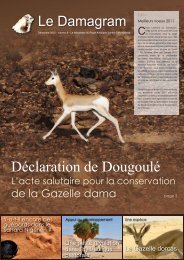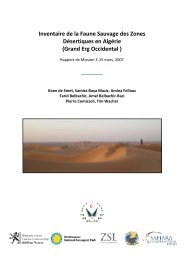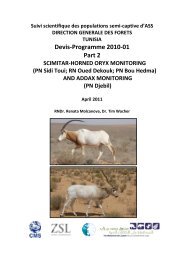The Biology, Husbandry and Conservation Scimitar-horned Oryx ...
The Biology, Husbandry and Conservation Scimitar-horned Oryx ...
The Biology, Husbandry and Conservation Scimitar-horned Oryx ...
You also want an ePaper? Increase the reach of your titles
YUMPU automatically turns print PDFs into web optimized ePapers that Google loves.
4<br />
Wild Diet<br />
TANIA GILBERT<br />
6<br />
Part 1: <strong>Biology</strong> & <strong>Conservation</strong><br />
<strong>Scimitar</strong>-<strong>horned</strong> oryx are primarily grazers. However, as an arid l<strong>and</strong> specialist, the species<br />
demonstrates a flexible foraging strategy (Newby, 1975b; Wakefield, 1996a), exploiting a<br />
range of additional plant materials including browse, seedpods of legumes, bulbs, tubers, <strong>and</strong><br />
succulents depending on season <strong>and</strong> availability (table 1.)(Macdonald, 2001; Kingdon, 1997;<br />
Dolan, 1966). Hence, previous authors describe the importance of these different food plants<br />
throughout the course of the year (Newby, 1975b; Devillers & Devillers-Terschuren, 2003).<br />
Information on the diet of wild scimitar-<strong>horned</strong> oryx is available from observations from<br />
Chad (Gillet, 1966a, 1966b; Newby, 1975b) prior to the species’ disappearance in the wild.<br />
More recently, this has been supplemented with knowledge gained from the reintroduction of<br />
scimitar-<strong>horned</strong> oryx to protected areas in Tunisia (Bertram, 1988; Gordon, 1991; Wacher,<br />
1986b; Davey, 1999; di Crocio, 2003).<br />
<strong>The</strong>re are three distinct seasons within the natural range of the scimitar-<strong>horned</strong> oryx: the rainy<br />
season; a cold, drier season; <strong>and</strong>, a hot dry season. <strong>The</strong> rainy season lasts from July to<br />
September in the Sahelian range (Devillers & Devillers-Terschuren, 2003), but begins in<br />
September in the northern Sahara fringe countries (E. Flach & S. Wakefield pers. comm.).<br />
During this period, scimitar-<strong>horned</strong> oryx in the Sahel fed on temporary pastures formed by the<br />
emergence of annuals <strong>and</strong> the green shoots of shrubs such as Indigofera sp. <strong>and</strong> Cordia<br />
sinensis. Tuft grasses including Cymbopogon schoenanthus provided grazing immediately<br />
after the rains, but oryx ab<strong>and</strong>oned this species <strong>and</strong> the browses in favour of more palatable<br />
grasses such as Cenchrus biflora, Panicum laetum <strong>and</strong> Dactyloctenium aegyptium as soon as<br />
they became available (Newby, 1975b). <strong>Scimitar</strong>-<strong>horned</strong> oryx migrated northwards following<br />
the rains <strong>and</strong> the formation of these temporary pastures (Gillet, 1965; Newby, 1974).<br />
Many plants remain green <strong>and</strong> thus provided continued grazing for oryx over the subsequent<br />
colder months between November to February. At the end of the cold season <strong>and</strong> the<br />
beginning of the hot season, scimitar-<strong>horned</strong> oryx ate large amounts the newly fallen Acacia<br />
seedpods of Acacia raddiana (Newby, 1975b). However, by the hot dry season from March to<br />
June, scimitar-<strong>horned</strong> oryx became reliant on perennial grasses, notably Panicum turgidum<br />
<strong>and</strong> Aristida sp., <strong>and</strong> browse species including Leptadenia sp., Cassia italica <strong>and</strong> Cornulaca<br />
monacantha also formed an important part of the diet (Newby, 1975b; Devillers & Devillers-<br />
Terschuren, 2003).<br />
In areas with low, sporadic rainfall <strong>and</strong> high rates of evaporation, the environment may be<br />
waterless for ten months of the year, but scimitar-<strong>horned</strong> oryx are perfectly adapted to cope<br />
with these conditions (Bremen & de Wit, 1983; Newby, 1981a; Davey, 1999; Dolan, 1966).<br />
<strong>The</strong> species can cope without free water for several months at a time, <strong>and</strong> it is reasonable to<br />
assume that they do not drink from the end of the rainy season until the first rains fall, a<br />
period of at least eight to ten months (Newby, 1975b, 1978a, 1978b; Anon, 1987a). However,<br />
when free water is available, the oryx will take considerable risks to get it <strong>and</strong> will gorge<br />
themselves, making it difficult for them to travel quickly over any distance (Newby, 1975b).





